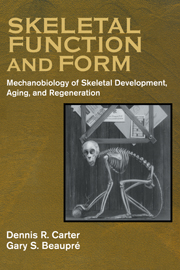Book contents
- Frontmatter
- Contents
- Preface
- Chapter 1 Form and Function
- Chapter 2 Skeletal Tissue Histomorphology and Mechanics
- Chapter 3 Cartilage Differentiation and Growth
- Chapter 4 Perichondral and Periosteal Ossification
- Chapter 5 Endochondral Growth and Ossification
- Chapter 6 Cancellous Bone
- Chapter 7 Skeletal Tissue Regeneration
- Chapter 8 Articular Cartilage Development and Destruction
- Chapter 9 Mechanobiology in Skeletal Evolution
- Chapter 10 The Physical Nature of Living Things
- Appendix A Material Characteristics
- Appendix B Structural Characteristics
- Appendix C Failure Characteristics
- Index
Chapter 8 - Articular Cartilage Development and Destruction
Published online by Cambridge University Press: 11 January 2010
- Frontmatter
- Contents
- Preface
- Chapter 1 Form and Function
- Chapter 2 Skeletal Tissue Histomorphology and Mechanics
- Chapter 3 Cartilage Differentiation and Growth
- Chapter 4 Perichondral and Periosteal Ossification
- Chapter 5 Endochondral Growth and Ossification
- Chapter 6 Cancellous Bone
- Chapter 7 Skeletal Tissue Regeneration
- Chapter 8 Articular Cartilage Development and Destruction
- Chapter 9 Mechanobiology in Skeletal Evolution
- Chapter 10 The Physical Nature of Living Things
- Appendix A Material Characteristics
- Appendix B Structural Characteristics
- Appendix C Failure Characteristics
- Index
Summary
Growth and Ossification Near Joint Surfaces
An appreciation of the mechanobiological factors influencing the development, adaptation, and repair of articular cartilage is critically important to understanding the joint pathologies that occur in the aging skeleton. Mechanically mediated endochondral growth and ossification proceed toward the articulations of developing bones. There the same factors that regulate endochondral ossification become involved in the histomorphological development and maintenance of articular cartilage. With advancing age, the articular cartilage destruction and the associated tissue reactions at joints are mediated by the same mechanobiological factors associated with endochondral ossification and skeletal regeneration (Carter, Rapperport, et al., 1987; Carter and Wong, 1990).
The mechanobiological factors regulating articular cartilage development at a typical joint can be illustrated by examining the developing anlagen of the hand. At birth, the ends of long bones in the hand have yet to ossify and the short bone rudiments, like the carpal bones in the wrist, are still entirely cartilaginous (Figure 8.1). At some long bone sites, such as the proximal 2–5 metacarpals and distal first phalanges, the primary ossification front will simply continue its advance toward the joint surface. A secondary ossific nucleus will not appear. As the ossification front approaches the articular surfaces at these locations, the rate of the advance diminishes. At maturity, the ossification front stabilizes under the articular cartilage, and further advance is so slow that it is usually considered negligible. The position at which the subchondral growth front stabilizes determines the thickness of the cartilage.
The rate of endochondral growth and ossification is determined by the baseline “biological growth rate” that is modified by local mechanobiological effects of the loading history.
- Type
- Chapter
- Information
- Skeletal Function and FormMechanobiology of Skeletal Development, Aging, and Regeneration, pp. 201 - 234Publisher: Cambridge University PressPrint publication year: 2000



